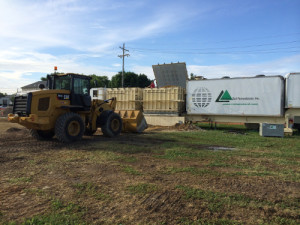Challenge
Mundell was retained to provide consulting services at a former electronics manufacturing facility in Seymour, Indiana. The facility had been the subject of several phases of environmental investigation by multiple consultants since 2006. Cumulative site investigations indicated the presence of chlorinated volatile organic compound (cVOC) impacts to both soil and groundwater.
Mundell investigations identified an on-site area of cVOC-impacted soil in the former location of an oil water separator. Based on groundwater analytical results, this area of impacted soil was a significant source of impacts to area groundwater. A dissolved cVOC plume was found to extend approximately a half-mile from the area beneath dozens of residential properties.
Removal or treatment of this soil source area was critical to achieving both on- and off-site remedial goals. However, disposal of the impacted soil via excavation was cost-prohibitive as chemical concentrations were found to greatly exceed associated RCRA “Land Ban” limits.
Action
Mundell evaluated several remedial technologies for use at the Site. Ultimately, low-temperature thermal desorption was selected as the most cost-effective and technically viable remedial strategy. Thermal desorption involves the excavation and on-site treatment of impacted soil using a closed-loop steam desorption unit. Impacted soil is mixed and blended with lime in-situ before being loaded into the treatment system in lifts of approximately 15 cubic yards. Superheated steam is forced through the impacted soil to volatilize adsorbed VOC constituents. Both the steam and VOC vapors are then recovered from the treatment chamber and condensed. Organic chemicals are then removed from the treatment wastewater using activated carbon, and the treated water is then cycled back through the process.
Results
Mundell completed the treatment of 1,272 tons of cVOC-impacted soil during fifteen (15) days of operation. IDEM personnel visited the site and viewed the thermal desorption process. In total, fifty-three (53) loads of soil were treated. MUNDELL collected both pre and post-treatment confirmation soil samples from each load to evaluate remedial progress. Based on the soil analytical results, the thermal treatment achieved over 99% removal of the adsorbed cVOC mass and met site remedial cleanup goals. The excavation area was then backfilled using the treated soil. In summary, the soil treatment was a success from both a cost and technical standpoint, achieving over 99% treatment effectiveness and saving our client up to $600,000 in hazardous material disposal fees.




